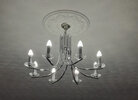- Joined
- 27 Jan 2008
- Messages
- 27,504
- Reaction score
- 3,325
- Location
- Llanfair Caereinion, Nr Welshpool
- Country

In the main, I agree. However the big problem is the bulb no longer emits light as intense or omnidirectional to the old tungsten bulb, so even if using bulbs, one often needs to change the lamp to suit the new bulbs, I ended up with thisThe integral, non-replaceable lamps do not fit my criteria for standard and simple replacement.
 instead of a single 150 watt bulb which did light the room, one they shine up to a white ceiling which spreads the light, but we still have 48 watt instead of 150 watt, and the on line charts say 28 - 23 watt, so I am using double what the conversion charts say.
instead of a single 150 watt bulb which did light the room, one they shine up to a white ceiling which spreads the light, but we still have 48 watt instead of 150 watt, and the on line charts say 28 - 23 watt, so I am using double what the conversion charts say.Outside I have carriage lamps, one odd one out with frosted glass is integral, and I have to admit it lights the area far better than the bulbs in lamps type. So I can see the point in the integral lamp, the LED's are arranged to give max output, however with a one off great, but with matching lights getting them to match when replacing is a problem, that 8 bulb chandelier had the bulbs changed as daughter complaining of a head ache, which seemed to cure the problem, and a couple have failed, the chandelier in old house proved too dim, so swapped the bulbs from 3 watt to 5 watt, bulbs not wasted, just moved elsewhere.
Many of my lamps now have smart bulbs, a smart switch typical £25 for type not needing neutral, smart bulb £9 so the bulb is the cheap method to get remote control, and the bulb can be colour charging, the same to dim lights, so easy with a smart bulb, no working out leading or lagging, or if the unit can be dimmed to start with, it just makes life easy changing a bulb.
This
